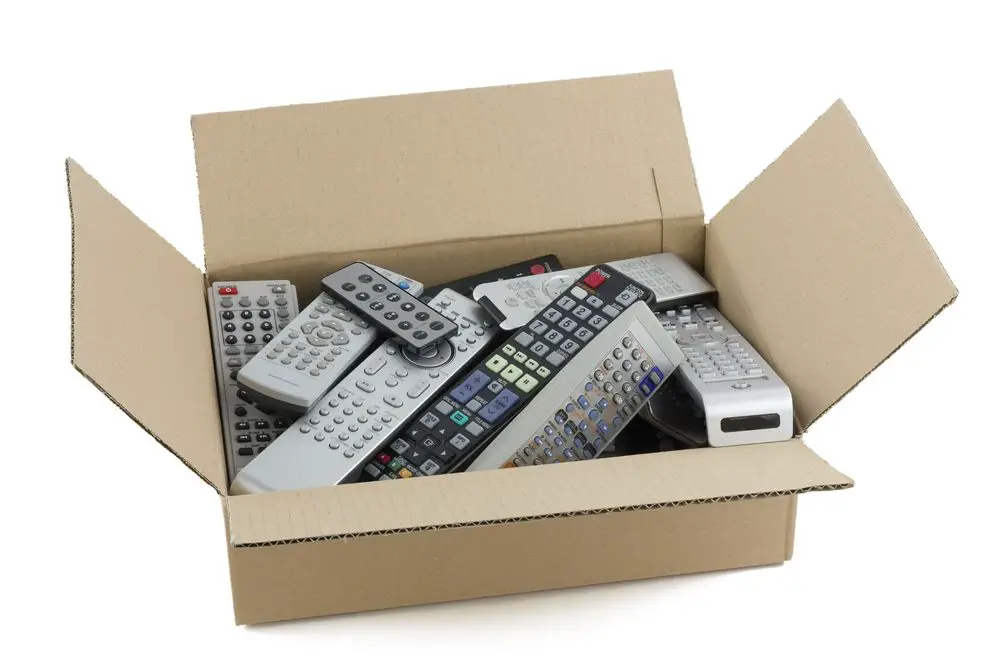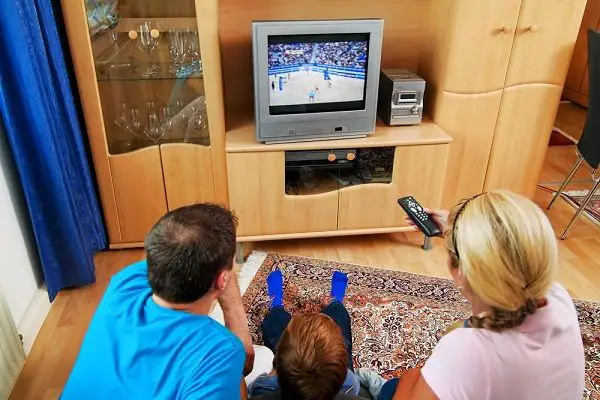
*As an Amazon Associate we may earn from qualifying purchases when you buy through links on our site.
While a remote control is a great idea for your TV, it’s also useful for your cable box and DVR as well.
But before you know it, you’ll have three or four of them sitting on your coffee table, or lost between seat cushions.
This means you’ll have to keep track of where they are, which device controls what, and whether they all have fresh batteries. The obvious solution is to have one device that controls everything.
What is a Universal Remote Control?
A universal remote is a single device that can be programmed to serve many remotely controlled electronic devices.
One easy and universal handheld device to control your TV, your cable box, your Bluray player, your home theater, and in some cases remote controls you don’t even have yet.

You can, for the most part, pick up those old product-specific remote controls and put them in a drawer. (Don’t throw them away, though! More later on why you might still need them.)
If the TV is capable of responding to remote control commands, yes, you can use different kinds of universal remotes for it. This is true not only for various television models but also for any peripheral device.
If the device came with a remote control, you can set up the universal remote to command most or all the device’s entertainment functions.
How Does a TV Remote Work?
TV signals of remote controls aren’t like the wireless signals that carry television programming. They’re not radio frequency (RF) waves. Instead, they’re infrared (IR) signals.
These are basically steams of light, but their (infrared) wavelength is slightly greater than the high end of the visible light spectrum, so we can’t see them. The receptors on our TVs can “see” them, though.
The TV-facing end of the remote device contains light-emitting diodes, and these propagate various patterns of IR pulses, depending on whether you power on, press the volume control, or select a channel.
The set translates these pulse patterns and knows how to respond to them. It’s sort of like turning a flashlight on and off to transmit a coded message.
Although IR is invisible, it’s a light signal and travels in a straight line and can’t go through walls. That’s why your remote stops working if a child stands in front of the set. It’s why you can’t command a DVR player behind a cabinet door unless the door is glass.
There’s a dizzying variety of universal remotes these days, but at a high level they can be categorized as multibrand remotes and learning remotes.
Multibrand Remotes
These are the traditional universal remotes that have been around since the 1980s. The basic unit in this class hasn’t changed much.
They “know” how to operate a wide range of devices and models when you tell them which TV, or DVD player, or other device you’re using by entering a code.
You have to associate an entertainment device to one of the buttons, usually on the top of the universal remote, that is labeled TV or DVD or AUX. The typical multibrand remote can be setup with up to four devices.
The advantage of these universal remotes is that they’re inexpensive and the easiest remote controls to understand, program, and operate.
The disadvantage is that they’re designed by manufacturers to support a finite range of devices each time, and thus may not work with something new that you buy in the future.
An example of a good and reliable multibrand remote is the GE Universal Remote Control. It comes in different colors and you can set it up with many different device brands:
How Do I Program a Multibrand Remote?
First you have to find the numeric code of the device for which you want to use the universal remote.
The manufacturer will provide an easy list or a website where these are found. In some cases there’s more than one code suggested for a device, and you may have to setup several of them to get a match.
While manufacturers’ instructions vary, in general you point the device’s remote at your universal remote. It’s better to line them up head-to-head so their IR sensors are facing each other.
Then press and hold the button you want to associate the device to (such as TV or DVD or AUX). While holding the button down, enter the numeric code.
If the operation has been successful, there’ll be a confirmation such as the power button lighting up. If it failed, you’ll usually see flashing lights, and you’ll have to try again or try a different code from the list.
(Some more advanced universal remotes will automatically search for the code or will search by brand name.)
Learning Remotes
As I mentioned, a disadvantage of the multibrand universal remote is that it may not support devices you buy in the future.
Another problem is that multibrand remotes sometimes don’t perform all the functions of the product-specific remotes they replace. For example, you may have to pull that old remote out of the drawer to enjoy the more advanced functions of your Bluray player.
If you have a learning remote, however, you can “teach” it learn whatever your old remote does. Furthermore, many learning remotes support macros, which allow you to issue several commands with the push of one button; for example, to turn on or off several of your devices at the same time.
An example of a learning remote is the Logitech Harmony 650. As you can see, it has an LCD screen and can control up to 8 devices.
How Do I Program a Learning Remote?
You point the old “teaching” remote and the learning remote at one another (head-to-head, as described previously).
Once you’ve followed the manufacturer’s instructions to get into learning mode, press the command you want to teach from the old remote, then press the button you want the universal remote to use.
While you can program anything, a disadvantage is that you have to follow the sequence button by button. There are newer devices that get around this limitation.
Other Types of Universal Remotes
PC Programmable: with one of these you use a computer to set up your remote. Typically you enter the model numbers of the devices you want to control and specify which buttons your remote will control them with. Then you download the instructions to your remote through a USB port or in some cases wirelessly or with Bluetooth. Your software will be updated with newer model numbers as new devices enter the market.
LCD Touchscreen: the touchscreen remote has a small screen, usually near the top of the remote. There are virtual buttons to program and control it. Some have physical push buttons as well. Many of these are PC programmable so that the setup can be done on a computer and downloaded.
Radio Frequency (RF): an RF remote uses RF waves, which can go through walls and control a TV or home theater from another room. These work in conjunction with IR blasters which sit in line-of-sight with the device and translate the RF signal to the standard IR signal our TV sets recognize.
Smartphones and Tablets: some smartphones have IR blasters and as extra hardware that will send an IR signal to the set, along with apps that manage these. Today, however, a more common approach is for phones and tablets to control an IR blaster.
Which TV Remote Will I Need?
It depends on how much you need and how comfortable you are with any complexity required. If all you want is to control a few devices without a cable, the multibrand remote may be the right choice.
Because it’s relatively inexpensive, you could look at it as an entry-level remote and move on later for more functionality.
The advantages of the more advanced remotes is that they enable nearly everything. This can also be their disadvantage.
It can be difficult to figure out what capabilities you need and how to program them. There are experts who will set up a programmable remote for a fee, or you may be comfortable watching YouTube tutorials.
In any case, hold on to those old remotes and put them in a safe place. Who knows, later on you may want to use, teach, or program one of their more obscure functions.


